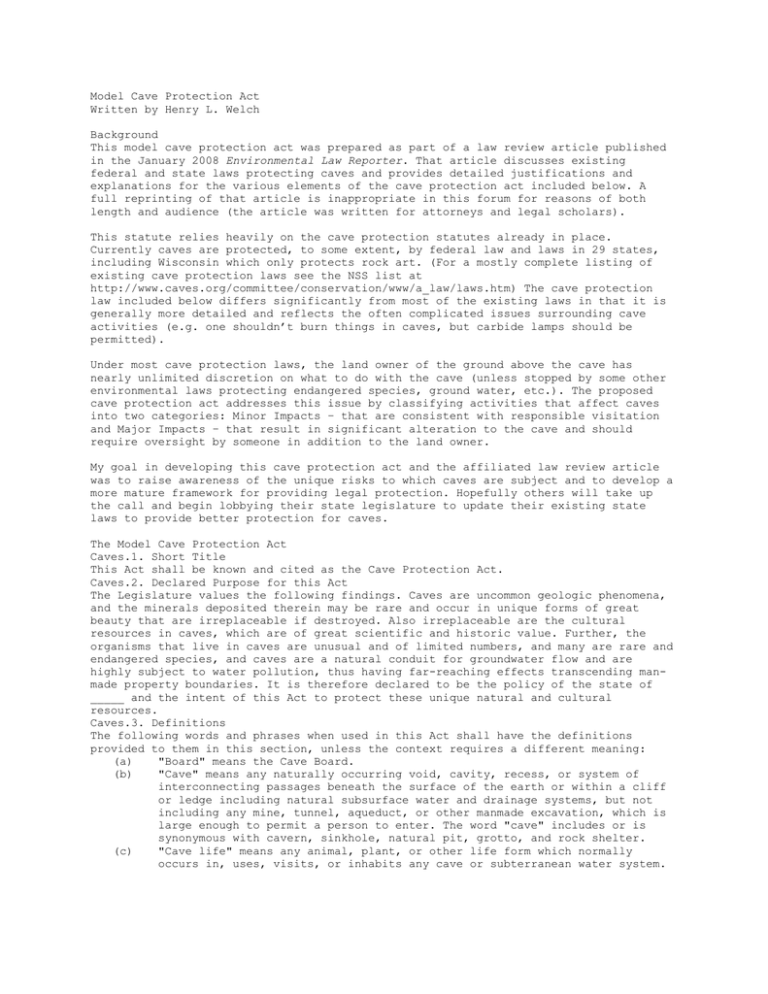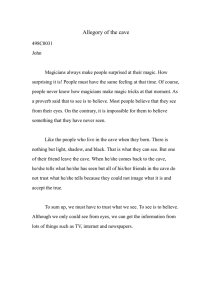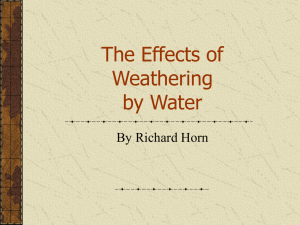Model Cave Protection Act Written by Henry L. Welch Background
advertisement

Model Cave Protection Act Written by Henry L. Welch Background This model cave protection act was prepared as part of a law review article published in the January 2008 Environmental Law Reporter. That article discusses existing federal and state laws protecting caves and provides detailed justifications and explanations for the various elements of the cave protection act included below. A full reprinting of that article is inappropriate in this forum for reasons of both length and audience (the article was written for attorneys and legal scholars). This statute relies heavily on the cave protection statutes already in place. Currently caves are protected, to some extent, by federal law and laws in 29 states, including Wisconsin which only protects rock art. (For a mostly complete listing of existing cave protection laws see the NSS list at http://www.caves.org/committee/conservation/www/a_law/laws.htm) The cave protection law included below differs significantly from most of the existing laws in that it is generally more detailed and reflects the often complicated issues surrounding cave activities (e.g. one shouldn’t burn things in caves, but carbide lamps should be permitted). Under most cave protection laws, the land owner of the ground above the cave has nearly unlimited discretion on what to do with the cave (unless stopped by some other environmental laws protecting endangered species, ground water, etc.). The proposed cave protection act addresses this issue by classifying activities that affect caves into two categories: Minor Impacts – that are consistent with responsible visitation and Major Impacts – that result in significant alteration to the cave and should require oversight by someone in addition to the land owner. My goal in developing this cave protection act and the affiliated law review article was to raise awareness of the unique risks to which caves are subject and to develop a more mature framework for providing legal protection. Hopefully others will take up the call and begin lobbying their state legislature to update their existing state laws to provide better protection for caves. The Model Cave Protection Act Caves.1. Short Title This Act shall be known and cited as the Cave Protection Act. Caves.2. Declared Purpose for this Act The Legislature values the following findings. Caves are uncommon geologic phenomena, and the minerals deposited therein may be rare and occur in unique forms of great beauty that are irreplaceable if destroyed. Also irreplaceable are the cultural resources in caves, which are of great scientific and historic value. Further, the organisms that live in caves are unusual and of limited numbers, and many are rare and endangered species, and caves are a natural conduit for groundwater flow and are highly subject to water pollution, thus having far-reaching effects transcending manmade property boundaries. It is therefore declared to be the policy of the state of _____ and the intent of this Act to protect these unique natural and cultural resources. Caves.3. Definitions The following words and phrases when used in this Act shall have the definitions provided to them in this section, unless the context requires a different meaning: (a) "Board" means the Cave Board. (b) "Cave" means any naturally occurring void, cavity, recess, or system of interconnecting passages beneath the surface of the earth or within a cliff or ledge including natural subsurface water and drainage systems, but not including any mine, tunnel, aqueduct, or other manmade excavation, which is large enough to permit a person to enter. The word "cave" includes or is synonymous with cavern, sinkhole, natural pit, grotto, and rock shelter. (c) "Cave life" means any animal, plant, or other life form which normally occurs in, uses, visits, or inhabits any cave or subterranean water system. (d) "Commercial cave" means any cave utilized by the owner for the purposes of exhibition to the general public as a profit or nonprofit enterprise, wherein a fee is collected for entry. (e) "Cultural resource" means all or any part of any archaeological, paleontological, biological, or historical item including, but not limited to, any petroglyph, pictograph, basketry, human remains, tool, beads, pottery, projectile point, remains of historical mining activity, or any other occupation found in any cave. (f) “Department” means the Department of Natural Resources, Department of Historical Conservation, or both as is consistent within the context in which the term is used. (g) “Educational purpose” means activities undertaken by museums, nature centers, and similar persons with the intent to prepare displays and exhibits for education of the general public. (h) "Gate" means any structure or device located to limit or prohibit access or entry to any cave. (i) “Hazard” means a risk of serious physical harm to persons or property. (j) “Major impact” means any significant impact to a cave that is generally done with a reckless or willful purpose. This includes, but is not limited to: converting a cave passage or room for commercial use and excavating more than a few cubic feet of material. (k) “Minor impact” means any incidental impact made to a cave that is consistent with responsible visitation and exploration. This includes, but is not limited to: the leaving of foot prints, disturbing loose materials as a result of passage, smoothing of non-speleothem rock surfaces caused by passage, introducing survey marks, placing climbing bolts for safety, installing cave gates, disturbing for scientific or educational purposes, and excavating a few cubic feet of material to make a passage passable. (l) "Owner" means a person who owns title to land where a cave is located, including a person who is a lessee of such land, and including the State and any of its agencies, departments, boards, bureaus, commissions, or authorities, as well as counties, municipalities, and other political subdivisions of the State. (m) "Person" means any individual, partnership, firm, association, trust, or corporation or other legal entity. (n) “Rescue personnel” means any police officer, fire fighter, paramedic, or recognized volunteer who is acting in response to an emergency or believed emergency. (o) “Scientific purposes” means research, or exploration, or both, conducted by persons affiliated with recognized scientific organizations with the intent to advance knowledge and to publish the results of exploration or research in an appropriate medium. (p) "Sinkhole" means a closed topographic depression or basin, generally draining underground, including, but not restricted to, a doline, uvala, blind valley, or sink. (q) "Speleogen" means an erosional feature of the cave boundary and includes or is synonymous with anastomoses, scallops, rills, flutes, spongework, and pendants. (r) "Speleothem" means a natural mineral formation or deposit occurring in a cave. This includes or is synonymous with stalagmite, stalactite, helectite, shield, anthodite, gypsum flower and needle, angel's hair, soda straw, drapery, bacon, cave pearl, popcorn (cave coral), rimstone dam, column, palette, flowstone, et cetera. Speleothems are commonly composed of calcite, epsomite, gypsum, aragonite, celestite, and other similar minerals. Caves.4. Vandalism It shall be unlawful for any person to intentionally, willfully, or recklessly: (a) (1) Break, break off, crack, carve upon, write, burn, or otherwise mark upon, remove, or in any manner destroy, disturb, deface, mar, or harm the surfaces of any cave or any natural material which may be found there, whether attached or broken, including speleothems, speleogens, sedimentary deposits, and cultural resources. (2) The provisions of this section shall not apply to minor impacts for which express permission has been received in advance from the cave owner. (3) The collection of samples for scientific or (b) (c) (d) (e) (f) (g) (h) Caves.5. It shall (a) (b) (c) Caves.6. It shall (a) (b) (c) (d) (d) Caves.7. It shall (a) (b) (c) (d) Caves.8. It shall (a) educational purposes requires that a permit be obtained from the Department or other agency as required by any other chapter in these statutes or by the United States Code. Break, force, tamper with, or otherwise disturb a lock, gate, door, or other obstruction designed to control or prevent access to any cave, even though entrance thereto may not be gained unless express permission has been received in advance from the cave owner. Remove, deface, or tamper with a sign stating that a cave is posted or citing provisions of this Act unless express permission has been received in advance from the cave owner. Excavate, remove, destroy, injure, deface, or in any manner disturb any cultural resource unless express permission has been received in advance from the cave owner and a permit has been obtained from the Department. Make a major impact to a cave unless express permission has been received in advance from the cave owner and a permit has been obtained from the Department. The provisions of this section shall not apply to the removal of unavoidable hazards provided they are mitigated with minimal impact to the cave. The provisions of this section shall not apply to rescue personnel in response to an emergency, believed emergency, or other rescue. Any violation of this section shall be punished as a felony. Disturbance of Cave Life be unlawful for any person to intentionally, willfully, or recklessly: Remove, kill, harm, or otherwise disturb any naturally occurring organisms within any cave unless it is a minor impact consistent with responsible visitation of the cave. The provisions of this section shall not be interpreted so as to lessen the restrictions on protections for cave life that may exist as a result of any other chapter in these statutes or by the United States Code. This includes any requirement for a collection permit. Any violation of this section shall be punished as a felony. Sale of Speleothems and Cultural Resources be unlawful for any person to: Sell, offer to sell, or trade in this State, import into this State, or export for sale or trade outside of this State any speleothems. Sell, offer to sell, or trade in this State, import into this State, or export for sale or trade outside of this State any cultural resources found in caves. The provisions of this section shall not apply to speleothems and cultural resources collected consistent with the scientific and educational purposes described in §Caves.4(a) of this Act. The provisions of this section shall not be interpreted so as to lessen the restrictions on the sale, trading, import, and exporting of cultural resources that may exist as a result of any other chapter in these statutes or by the United States Code. Any violation of this section shall be punished as a felony. Pollution be unlawful for any person to: Burn within a cave or sinkhole any material that produces any smoke or gas which is harmful to cave life or may cause damage to speleogens and speleothems. Store, dump, litter, dispose of, or otherwise place any refuse, garbage, dead animals, sewage, or toxic substances harmful to cave life or humans, in any cave or sinkhole. The provisions of this section shall not prohibit the operation within a cave of any source of flame capable of being carried in the hand or attached to a person, provided that the light source is used consistent with a minor impact on the cave. Any violation of this section shall be punished as a felony. Gates be unlawful for any person to: Install, alter, or maintain a cave gate or other obstruction at a cave entrance or within a cave that alters the ability of cave life, water, and air to pass through the obstruction that is inconsistent with a minimal impact on the cave. This means that any gate or obstruction should neither appreciably increase nor decrease the ability of cave life, water, and air to pass through the obstruction prior to recent alteration of the area so gated by persons. (b) Gates or obstructions which significantly alter the ability of cave life, water, and air to pass through the obstruction are considered to be major impacts and are subject to §Caves.4(e) of this Act. (c) Any violation of this section shall be punished as a felony. Caves.9. State Cave Board (a) The Cave Board shall be constituted within the Department of Natural Resources and shall consist of the Director of the Department of Natural Resources, the Director of the Department of Historical Conservation, and ten citizens of the State appointed by the Governor for four-year terms. Appointments shall be made on the basis of activity and knowledge in the conservation, exploration, study, and management of cave and should include members who can represent the interests of the State, scientists, historians, cave owners, commercial cave owners, and cavers. (b) The Cave Board shall meet at least three times a year. (c) The Cave Board may perform all tasks necessary to carry out the purposes of this Act, including, but not limited to, the following: (1) Accept any gift, money, security, or other source of funding and expend such funds to effectuate the purposes of this chapter. (2) Provide cave management expertise to requesting public agencies and cave owners. (3) Provide cave data for use by state and other governmental agencies. (4) Publish or assist in publishing articles, pamphlets, brochures, or books on caves and cave-related concerns. (5) Facilitate data gathering and research efforts on caves. (6) Inform the public about cave resources and the importance of preserving them for the citizens of the State. (7) Develop regulations necessary to advance the purposes of this Act including: (a) Further clarify the difference between minor and major impacts. (b) Develop rules and procedures for applying for and obtaining permits required under §§Caves.4(a)(3), Caves.4(d), Caves.4(e), Caves.5(b), and Caves.8(b) of this Act. (d) Any data collected by the Cave Board or included in the minutes or transcripts of its meeting will not be subject to freedom of information requests. Caves.10. Liability of Owners and Agents Limited; Sovereign Immunity of the State not Waived (a) Neither the owner of a cave nor his authorized agents acting within the scope of their authority are liable for injuries sustained by any person using the cave for recreational or scientific purposes if no charge has been made for the use of the cave, notwithstanding that an inquiry as to the experience or expertise of the individual seeking consent may have been made. (b) Nothing in this section shall be construed to constitute a waiver of the sovereign immunity of the State or any of its boards, departments, bureaus, or agencies.



